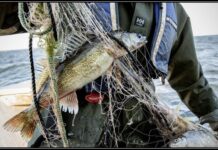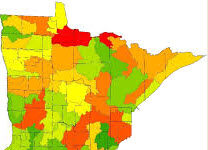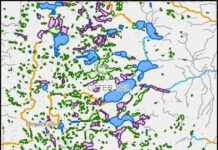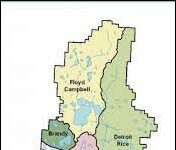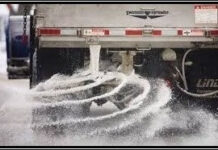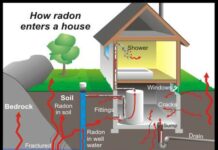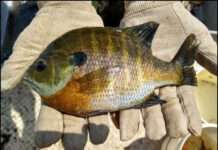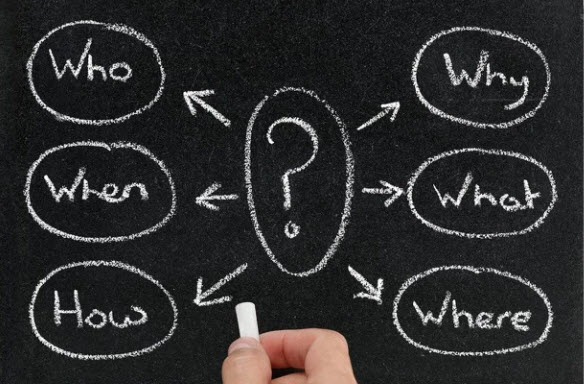If you are someone that needs to create content in order to connect with your audience, then you may find it difficult to produce quality material on a consistent basis. If that’s your situation, then using a well-worn writer’s technique called the “reporter’s questions,” or “the 5 W’s and the H” may be just what you need.
The 5 W’s and the H refers to the six questions that a reporter should answer in the lead paragraph of a news story (as long as they are relevant and make sense). The questions are the following:
- Who
- What
- When
- Where
- Why
- How
5 W’s and the H – Question Guide for Brainstorming
But even if you aren’t a reporter, you can still use these questions to help you brainstorm for ideas and map out an outline for your content.
Below is a list of the questions and some possibilities for each. The questions provided are as general as possible in order to provide a guide that you might use for any topic. For that reason, they may seem a little strange unless you have a specific topic in mind.
Who
- Who is involved?
- Who is affected?
- Who will benefit?
- Who will be harmed?
What
- What is your topic narrowed down in a simple phrase/sentence?
- What does your topic involve? (i.e. What are the different parts to it?)
- What is it similar to / different from?
- What might be affected/changed by your topic?
When
- When does this take place? When did this take place? When will it take place? When should this take place?
- Does when this takes place affect the topic?
Where
- Where does this take place? (Where did it …. Where will it … Where should it ….?)
- Does it matter where it takes place? Is it affected by location?
Why
- Why is this topic important? Why does it matter?
- Why do certain things happen? (What are some causes and effects within the topic?)
How
- How does this topic work? How does it function? How does it do what it does?
- How did it come to be?
- How are those involved affected?
There is another question that I will throw in here: “What if?” What if is not a question a reporter would typically use, not in the lead paragraph anyway, but it’s often an excellent question to ask for other types of situations.
What If
- What if everything worked as it should?
- What if everything didn’t work as it should?
- What if this topic didn’t exist?
An Example: Answers to the 5 W’s and the H
In order to make these questions more concrete, I will go through each of the questions and show you the answers I came up with in the writing of this post.
It’s important to note that this is a BRAINSTORMING technique. When you’re answering the questions, you shouldn’t worry too much about whether your ideas are perfectly expressed or even if they’re good! The idea behind brainstorming is to GET QUANTITY, NOT QUALITY.
Once you have a lot of ideas down on paper (or on the screen, as the case may be), then you can go back and pick out the ones that seem to have the most merit.
So, here’s my brainstorm for this topic, which is “using the 5 W’s and the H as a brainstorming technique.”
Who
Who is involved?
- Anyone who produces or consumes content. – Bloggers, designers, developers, clients.
Who is affected?
- Anyone who produces or consumes content. – Same as above.
Who will benefit?
- Both the creators and the consumers will benefit.
Who will be harmed?
- No one harmed, however, it will take effort on the part of the creator.
What
What is your topic narrowed down in a simple phrase/sentence?
- It’s a brainstorming technique that consists of six questions: Who, What, When, Where, Why, and How.
What does your topic involve? (i.e. What are the different parts to it?)
- It involves going through and answering a series of questions. It also involves creating new questions.
What is it similar to / different from?
- It’s similar to other types of prompts, to anything that’s meant to stimulate you and help you to see deeper into a subject. It’s also similar to a checklist.
- It’s different from just winging it and not going through your topic in a systematic way.
What might be affected/changed by your topic?
- The quality of the content might be affected (for the better, of course). It can lead to more details and a more thorough examination of the topic.
- The ease at which the content is created might be affected. Could be easier because the questions act as a guide. Could also be more “difficult” in some ways because it forces you to think and consider things on a deeper level. In the end, however, even though that may be more “difficult,” it should result in better content.
When
When does this take place? When did this take place? When will it take place? When should this take place?
- The brainstorming can take place at many points in the writing process. It should take place at the beginning in order to generate ideas and to help map out directions. But it can take place for individual points within the larger points. This can be done during the revision stage.
Does when this takes place affect the topic?
- Doing it at the beginning of the writing process is ideal. Doing it later in the writing process can also be beneficial in order to delve more deeply into certain points.
- It may help to use other brainstorming techniques before using this one in some cases, especially if the content creator is having a difficult time pinning down ideas or getting a hold of the topic.
Where
Where does this take place? (Where did it …. Where will it … Where should it ….?)
- It can take place digitally (on computer, online) or it can be done with paper. Essentially, however, it takes place in the mind. It forces you to reach into your mind for answers. And if they aren’t there, it may force you to look for answers elsewhere – to research them.
Does it matter where it takes place? Is it affected by location?
- That depends on personal preference.
Why
Why is this topic important? Why does it matter?
- It helps in generating ideas.
- It helps in being thorough.
- It helps in mapping out a direction/creating an outline.
- It helps in answering questions others might have.
- It helps in creating questions that others should have thought of but didn’t.
Why do certain things happen? (What are some causes and effects within the topic?)
- The questions force you to approach the topic from many different angles.
- They force you to be thorough.
- They help you think of new ideas.
- They make the process of generating ideas easier.
How
How does this topic work? How does it function? How does it do what it does?
- It works by prompting you.
- It works by making you go deeper than you might have “on your own.”
- It works by making you look at things from several angles.
How did it come to be?
- It came from journalism originally.
- It has since been adopted by many writers as a technique for brainstorming.
How are those involved affected?
- It makes it easier for a content creator to delve deeper into a topic.
- It relieves some stress placed on the creator because he/she knows that answering the questions will at least produce some good ideas to work with.
What If
What if everything worked as it should?
- If everything worked as it should, then a content creator would be able to easily create quality content after running through the questions.
What if everything didn’t work as it should?
- If it didn’t work as it should, then the creator would possibly abandon the project.
- If it didn’t work as it should, then the creator would possibly be left with more answers than questions. However, having questions that can be investigated would probably still lead to quality content, and possibly even better content because those eventual answers may be hard to come by for most – and therefore would be perceived as more valuable.
What if this topic didn’t exist?
- It this technique didn’t exist, then content creators wouldn’t necessarily have a sure-fire way to make sure they were covering their topics from all the essential angles.
A Finished Example
By the way, did you notice that I actually answered five of the six questions in the lead of this post? Although this isn’t a “news” story, it can still be an effective technique.
Here are short answers that I pulled out of my notes in order to help me write the lead paragraph.
- Who – content creators
- What – brainstorming technique: 5 W’s and the H
- When – when they need to create content; in the exploring stage
- Where – (not really so important here)
- Why – to easily explore the topic in detail and give direction to the content; produce quality
- How – by answering a set of simple questions that come at the topic from different angles
And here is the lead paragraph with five of the six answers incorporated. You’ll notice that they aren’t the word-for-word answers from above, but the ideas are still there.
If you are someone that needs to create content in order to connect with your audience (who), then you may find it difficult to produce quality material (why) on a consistent basis (when). If that’s your situation, then using a well-worn writer’s technique (how) called the “reporter’s questions,” or “the 5 W’s and the H” (what) may be just what you need.
(Note: “Where” is not really essential for the lead paragraph in this case.)
Joe Foley – December 8, 2011
https://premium.wpmudev.org/blog/a-simple-sure-fire-way-to-create-great-content-the-5-w-the-h/




